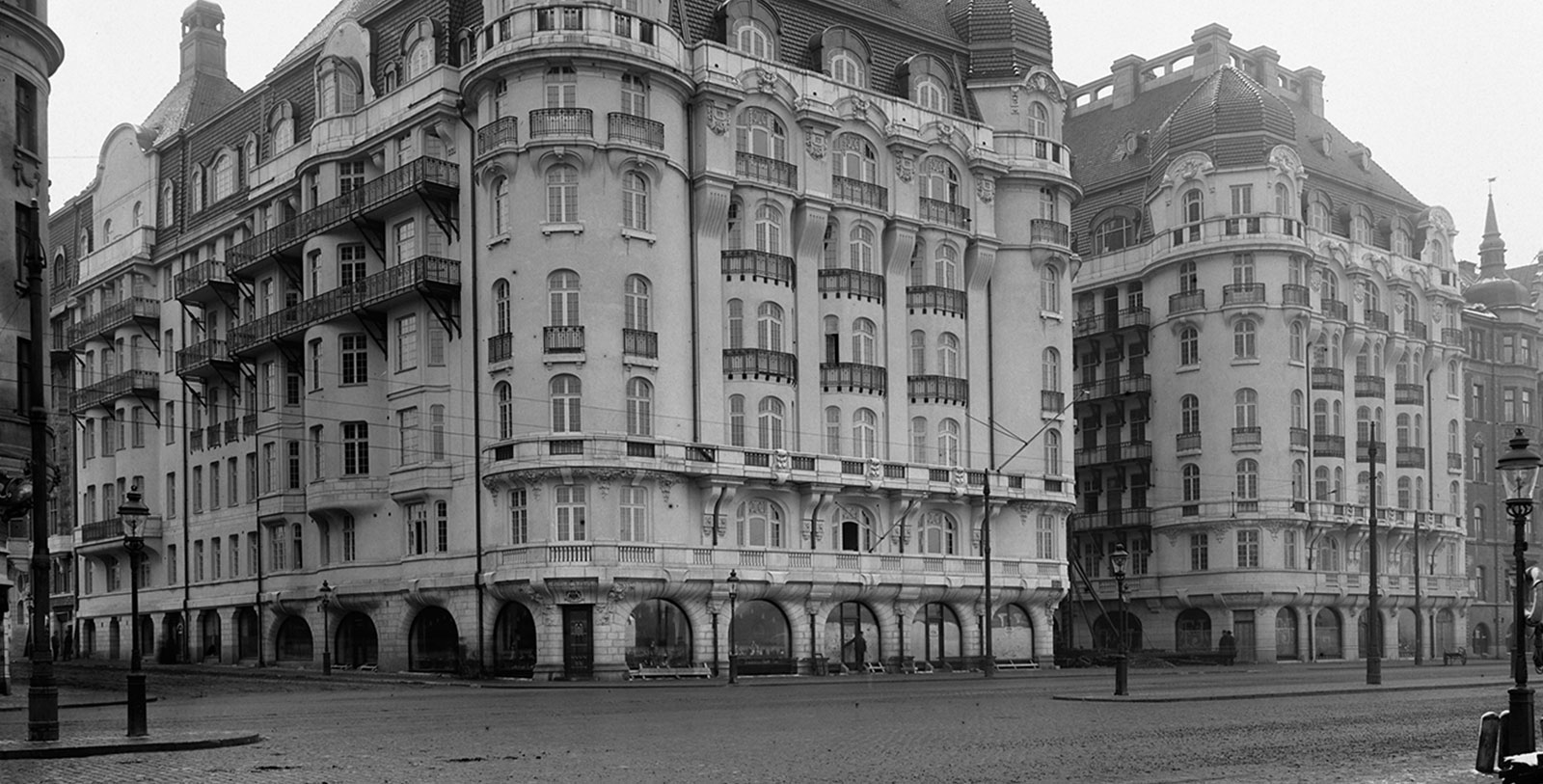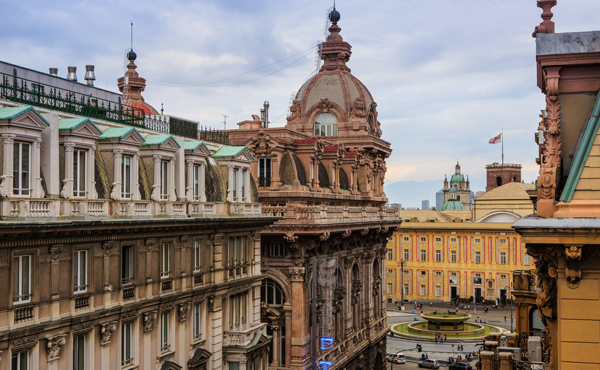Receive for Free - Discover & Explore eNewsletter monthly with advance notice of special offers, packages, and insider savings from 10% - 30% off Best Available Rates at selected hotels.
history
Discover the Hotel Diplomat, which was once the official embassies for Romania, Chile, Persia, Hungary, Italy, and Canada.
By the 1870s, Stockholm was expanding unlike ever before. The city had undergone a rapid transformation due to an influx of trade to the region, which lead to the proliferation of new buildings in every neighborhood. Countless glorious structures made their grand debut, including the likes of the Naitonalmuseum, the Armémuseum, and Stockholm University. Even large historical districts were completely renovated to feature buildings that displayed the latest architectural forms of the age. Among the areas redeveloped at the time was the swampy Östermalm neighborhood, which local engineers drained considerably for both residential and commercial structures. Construction began immediately, which transformed it into one of Stockholm’s most desirable districts. Nearly all of Östermalm had been changed in just a single decade, with some 83 magnificent buildings lining its beautiful streets. King Oscar II even directed the construction of a spectacular roadway through the heart of the district, calling it the Strandvägen. Yet, at the dawn of the 20th century, only one lot remained untouched: Strandvägen 7. Then in 1907, architects Per Bocander and J. Eriksson of the firm Hagström & Ekman began to construct a towering palace at the site. Comprised of two wings built around a central courtyard, the edifice displayed some of the finest Art Nouveau architecture in all of Stockholm. And when the structure finally debuted after four years of continuous construction, it stood as one of the most beautiful buildings in Östermalm.
In 1917, the affluent Malmström family purchased the eastern wing of the palatial mansion. The new owners were specifically Karl and Dagmar Bersten, the maternal grandparents of the Hotel Diplomat’s current chairperson, Anna Cappelen. The Malmströms subsequently lived in the building for the next several decades, even as the Great Depression forced most of the tenants out. Over time, some of the vacated apartments and guestrooms became a small lodging house known as the “Strandvägspensionatet.” But most of the accommodations served as the temporary embassies for various nations, including Romania, Chile, Persia, Hungary, Italy, and Canada. All of the embassies left the premises once the crisis had passed, though, and the Strandvägspensionatet gradually acquired all of the empty spaces. The Strandvägspensionatet became immensely popular, growing into a fully functional hotel by the 1960s. Sune Malmström of the Malmström family had spearheaded its transformation, acquiring the entire business in 1966. He even rechristened the structure as the “Hotel Diplomat” in honor of its venerable past as the home for many prominent politicians and ambassadors. Today, the Hotel Diplomat is still owned by the Malmströms, who have since elevated it into one of Stockholm’s premier holiday destinations. It is also now a member of Historic Hotels Worldwide, which is a prestigious collection of more than 360 of the finest historic treasures found throughout the globe.
-
About the Location +
Stockholm’s earliest history remains somewhat shrouded in mystery, as only one canonical source—the Eric Chronicles—exists to provide any ascertainable details. According to the medieval tome, a feudal lord named Birger Jarl landed on the island of Riddarholmen in 1252. Prior to that point, the region of today’s present-day Stockholm was little more than a hinterland, occasionally visited by Viking marauders who traveled down the Baltic Sea to launch expeditions all over Europe. (Sweden itself did not become a unified kingdom until the start of the 11th century). Jarl had specifically arrived on Riddarholmen to erect an imposing fortress as a means of protecting Swedish mariners out on Lake Mälaren. Yet, other legends endure that persist Stockholm was founded much earlier by a group of settlers from the town of Sigtuna. Constructing a fleet of rustic log barges, the villagers left Sigtuna with the intention on creating a new home wherever the currents of the ocean took them. The rafts eventually reached the Riddarholmen on Lake Mälaren, which the settlers immediately developed into a town called “Stockholm.” The settlers had decided to christen their new town “Stockholm,” in honor of their arduous journey down the Baltic Sea. “Stock,” in essence, meant “log,” which, according to the tale, was an homage to their rudimentary ships. “Holm,” on the other hand, translated as “island,” thus signifying their permanent relocation to the Riddarholmen. Even though most modern scholars speculate that Stockholm first emerged as a result of Birger Jarl’s efforts, the myth of the Sigtuna settlers still persists to this very day.
Nevertheless, Stockholm had become one of the most commercially vibrant cities in northern Europe by the end of the 14th century. Upon the invitation of local Swedish feudal lords, German merchants from the nearby Hanesatic League relocated en masse to the settlement. As such, they created an expansive landscape of wharves, warehouses, and storefronts that all serviced the city’s powerful maritime trade. The Gamla Stan served as the central neighborhood in Stockholm throughout this transformation, with most of the German transplants settling within its borders. (Even though most of the German families integrated and adopted Swedish culture, their influence has nonetheless preserved over the ages in the Gamla Stan. Many buildings in the Gamla Stan still possess their historical Germanic architectural appearance today.) In 1389, Stockholm and the rest of the Kingdom of Sweden joined together with Denmark and Norway to form the powerful Kalmar Union. Both Sweden and Norway were junior partners in the political relationship though, as the monarchs of Denmark presided over the unification. But Stockholm’s economic importance remained strong under Danish rule, and it was elevated to Sweden’s nominal capital by the middle of the 1400s. Yet, local Swedes around Stockholm resented their status as Danish subjects and occasionally staged rebellions to reestablish their own sovereignty. Perhaps the most violent clash was known as the “Stockholm Bloodbath,” in which King Christian II of Denmark executed some 100 nobles and clergymen for their dissidence. After many years of turmoil, final victory for the Swedes came when Gustav Eriksson Vasa led a successful uprising in 1523.
Crowned as King Gustav I, he subsequently made Stockholm the seat of royal power for the newly liberated Sweden. He oversaw a massive renaissance within the city, as many new, beautiful neighborhoods emerged under his direct supervision. The Kingdom of Sweden as a whole became a major European superpower, in which King Gustav I beat back the Danes countless times. His descendants continued the struggle as well, defeating Denmark upon several occasions during the Thirty Years’ War. By the beginning of the 18th century, Sweden was the most dominant force in northern Europe. But Sweden’s geopolitical preeminence was not destined to last, as it saw its might shrink considerably from its losses in the Great Northern War of 1701 to 1711. Stockholm suffered, too, as its population was beset by a ravishing wave of the Bubonic Plague. Fires also spread across Stockholm, destroying many of the historic wooden buildings that lined its streets. But both Stockholm and Sweden recovered from the tribulations, enjoying great economic prosperity by the start of the 1800s. Stockholm underwent a grand transformation, with its historic districts reconstructed with many “contemporary” buildings. Some of the most iconic structures in the city debuted at this time, such as the Stockholm Central Railway Station, the Nationalmuseum, the Armémuseum, and Stockholm University. Stockholm only continued to flourish in the 20th century, largely spared the devastation of World Wars I and II. Stockholm today accounts for about a third of Sweden’s annual GDP, and is one of the most affluent cities in all of Europe. It is also home to a lucrative tourism industry, driven by its many amazing cultural attractions like the Moderna Museet, the Skansen, the Kungliga Djurgården, and the Kungliga Slottet.
-
About the Architecture +
Constructed in the early 20th century, the Hotel Diplomat displays some of the finest Art Nouveau architecture in all of Stockholm. Part of the greater cultural phenomenon known as the “Belle Époque,” Art Nouveau architecture was among the most popular styles in Europe from the 1890s till the outbreak of World War I. It quickly appeared all across the continent, referred to by such names like “Glasgow Style,” “Modern Style,” and “Sezessionsstil.” And some of Europe’s most prominent architectural minds employed Art Nouveau architecture. Perhaps the greatest example Hector Guimard’s wonderful Castel Béranger. The term itself was derived from an article published in the L’Art Moderne to introduce the work of architectural collective Les Vingt toward the end of the 19th century. Architects who embraced the Art Nouveau were among a growing demographic of intellectuals that yearned to create novel artistic forms that broke with the imitative historicism of the past. More importantly, they wanted their new architectural motifs to reflect imaginative creativity, especially as European society became increasingly more structured and industrialized. Over time, those professionals created a design aesthetic characterized by its curvaceous lines and use of organic shapes. Objects from nature were featured prominently throughout the façade of every structure, too, including the likes of insects and exotic plants. Surfaces often contained terra cotta coverings, and ornate tile moldings spread throughout the interior. Sloped arches also defined the windows and doors, while fantastic mosaics existed on nearly every ceiling. Asymmetrical layouts structured many Art Nouveau buildings, as well, providing for a unique appearance in many of Europe’s sprawling cities. Art Nouveau architecture was eventually phased out during the 1920s in favor of a new style known as “Art Deco.” Its emphasis on modernity seemed to better represent Western culture as it emerged from the aftermath of World War I.



























